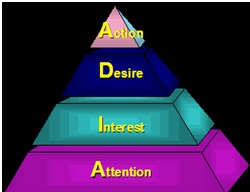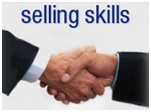|
 |
|
 |
Personal selling
Personal selling is... Face to face selling to customers, carried out by the organization’s salespeople or sales force.
Where is it used? Personal selling is particularly important for:
Why is it useful? It is expensive but creates close relationships with customers who can ask questions. The salesperson can ask for an order and negotiate on price. Telephone selling is cheaper but more impersonal and irritating.
What is the Pareto 80/20 rule? 80% of sales (or profits) come from 20% of products (or people).
How to sell well (AIDA)
AIDA summarizes the four key points of successful selling: attention, interest, desire and action. We shall now look at these in more detail.
1. Attention First impressions should grab the potential buyer’s attention, so:
2. Interest A salesperson has around 15 seconds to create some interest by emphasizing the product’s unique perceived benefit (UPB) that competitors can’t offer. People only buy benefits i.e. the difference the product will make to their organization and them personally. Such benefits will come from its features and advantages (these three things that buyers look for are called FAB’s). For example, the iPhone's (pictured right) FAB's are:
3. Desire Customers will desire a product, if its benefits are perceived as valuable and unique (i.e. better than competitors). So a salesperson must:
4. Action This is the decision to buy (perhaps after negotiation e.g. over price) leading to the completion of the sale (called closure). The buyer will need little or no encouragement to do so, if the salesperson has done his (or her) job properly. Closure shouldn’t be seen as the end but the start of a long-term customer relationship that delivers repeat purchases.
Key quotes explained
“The aim of marketing is to know and understand the customer so well the product or service fits him and sells itself” - Peter Drucker , American management writer (pictured right) Great products sell themselves, because they provide benefits to customers including intangibles like image and psychological well-being. “In the factory we make cosmetics; in the store we sell hope”, said Charles Revson, founder of Revlon cosmetics.
“The successful salesperson cares first for the customers, second for the products” - Philip Kotler, American marketing professor (pictured right) How salespeople talk to customers is vital. “A soft answer turns away wrath but grievous words stir up anger”, the Bible’s Book of Proverbs says.
“Never treat your audience as customers, always as partners” - James Stewart , American film star (pictured right) Customers must be treated as equal partners and persuaded to buy with integrity and mutual trust and respect. But there is a fine line between persuasion and manipulation. The founder of McDonald’s, Ray Kroc, said, “The definition of salesmanship is the gentle art of letting the customer have it your way”.
Best books
Dale Carnegie (pictured right) , How To Win Friends and Influence People (1936) The only way to influence people is to talk enthusiastically about what they want and show them how they can do it. So be friendly (don’t criticize) and understand their needs and point of view. (For more detail see How To Win Friends and Influence People in the Business Books section).
Robert Miller (pictured right) and Stephen Heiman , The New Strategic Selling (1985) Salespeople should concentrate on not only the most likely customers (the “best few”) but also potential customers in the “sales funnel” who have been contacted and are listening to what you’ve got to say. Don’t focus on competitors but customer benefits.
Robert Cialdini (pictured right) , Influence (1984) There are six ways to persuade people to buy:
Jack Mitchell (pictured right) , Hug Your Customers (2003) Make your customers special e.g. by sending personal letters to big customers. |
|
|
||
|
|
|
||
|
||
| Copyright © wisdomtowin.com All Rights Reserved | ||
|














